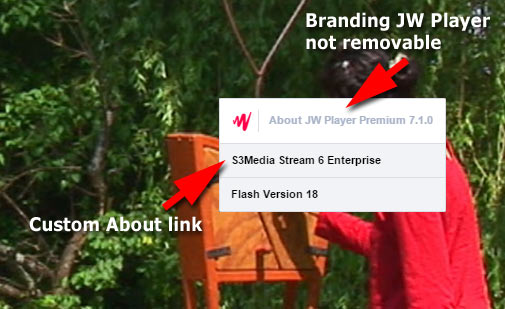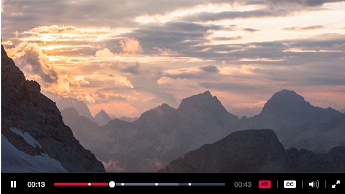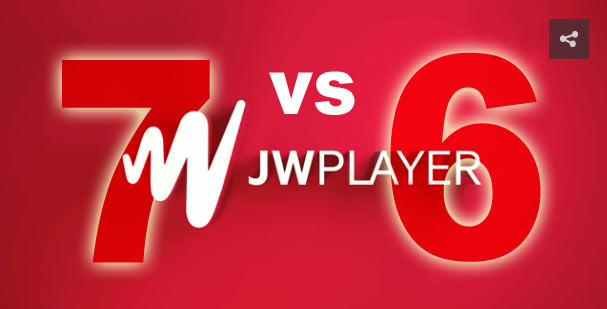Updated: 2 December 2016. A comparison between JW Player 7 and JW Player 6. What are the differences? Do you need to update your embedding code? Price policies and other changes explained. Updated 10 November 2015.
What is the difference between JW Player 6 and JW Player 7?
With JW Player 7, the company JW Player in New York clearly goes for the big enterprises and organizations. And this has in the long run its consequences. For instance, although RTMP streaming is still supported, they hope to depreciate it in the (unknown) future. RTMP streaming has namely two problems, it cannot pass company firewalls and it has to switch to progressive download on mobiles via the HTML5 fallback method. In other words, videos do not play in governmental environments and other large organizations.
Therefore, JW Player 7 introduces MPEG-DASH which can play on more devices in HTML5 mode than HLS streaming, although quite a few borwsers do not support it yet. Both methods can circumvent firewalls.
However, it remains to be seen whether RTMP will disappear because RTMP streaming remains quite popular as it is easy to implement and gives good results. Fact is, that the video industry changes all the time, predictions are in that sense a little pointless.
Comparison table JW Player 6 and 7
| JWplayer | Version 6 | Version 7.7 |
| JWplayer license: | Free Pro version $149 Premium version $299 |
Free Pro (replaced by free) Premium version $299 |
| Media types Free version: |
RTMP Streaming Video/Audio Progressive download Video/Audio |
RTMP Streaming Video/Audio Progressive download Video/Audio |
| Media types Paid versions: |
HLS Live streaming (Premium only) HLS Adaptive streaming (Premium only) RTMP Streaming Video/Audio Progressive download Video/Audio |
HLS streaming Multi-track Audio Live with DVR Windowing MPEG-DASH Live and DVR Streams RTMP streaming Video/Audio Progressive download Video/Audio NOTE: RTMP will be deprecated soon! |
| Media formats | Video: MP4, WebM and FLV. Audio: AAC, MP3 and Vorbis. YouTube videos, using the official iFrame API. RSS feeds, using enclosures or the Media or JWPlayer extension. |
Video: MP4, WebM and FLV. Audio: AAC, MP3 and Vorbis. YouTube videos, using the official iFrame API. RSS feeds, using enclosures or the Media or JWPlayer extension.More info >> |
| Subtitles/captions: | Multilingual (Pro/Premium) | Multilingual |
| Poster image: | For audio & video | For audio & video |
| Autostart: | Yes | Yes |
| Responsive video player: | Yes | Yes |
| Video stetching: | Uniform/fill/exact fit/none | Uniform/fill/exact fit/none |
| Controlbar: | over/none | over/none |
| Repeat media:
HD switching |
Yes
No |
Yes
Yes (since version 7.7) |
| Enable/disable Full screen button: | Yes | No, full screen cannot be prevented. |
| Playlist types: | .rss, .smil, .m3u8 | .rss, .smil, .m3u8 |
| Social sharing button: | Yes (Pro/Premium only) | Yes |
| Custom Logo/Watermark | Yes (Pro/Premium only) 4 possible positions Shows only a rectangle on mobiles |
Yes (*) 4 possible postions (from 7.4.3) Shows fine on mobiles |
| Analytics | Yes (Pro/Premium only) | Basic free/Advanced (Premium only) |
| HTML5 Fallback for RTMP | Yes | Yes, based on source order. No longer a separate tag. |
| Custom context menu | Yes (Pro/Premium only) | Yes (*) |
| Skins | 9 skins, XML based | 9 skins, CSS based |
| Title | Displays in play button | Displays top left |
* From version 7.2 onward, you can again customize the context menu although you cannot remove the link to JW Player. The watermark is also available in all JW player editions and from version 7.4;3 onward, the 4 positions top-left, top-right, bottom-left and bottom-right are again possible.
Detailed info
Important to note is that JW Player 7 performs faster than version 6 due to a couple of improvements, like skins are lighter, and Flash is only used when needed.
HLS streaming and MPEG-DASH require a yearly JW Player Premium license of $299 at this time of writing.
HLS streaming was already supported in the Premium version of JW Player 6, but this method is actually quite problematic as not all Android devices support it properly. JW Player believes, or rather hopes, that MPEG-DASH will replace HLS and RTMP streaming in the future. This remains to be seen, of course, but a fact is that MPEG-DASH is gaining support, although not supported on all browsers yet.
HLS adaptive streaming will replace RTMP streaming quite soon(see also Flash support in Google Chrome under fire).
MPEG-DASH and HLS Adaptive streaming powerful as these options may be, it is not for beginners because it is more complex than RTMP streaming and the cost is higher in terms of data transfer and encoding. However, nothing stops you from using RTMP, as long as you provide an HTML5 falback to progressive download.
But let me repeat, the RTMP days are numbered as it requires Flash.
The JW Player 7 free version features the old Pro options:
- Custom branding options
- 9 Pre-Built Skins
- Social Sharing button
- Related Videos Overlay
These options were not available in the free JW Player 6 version.
NOTE: There are some caveats in the Custom branding options in version 7.1 and 7.1.4. Whereas JW Player 6 Pro gave you full control over the context menu, skins and watermarks, the free JW Player 7 version has some limitations:
 The context menu is no longer fully customizable. The “About JW Player” cannot be removed unless you change it in the jwplayer.js file itself, but this is officially not permitted by JW Player, so be careful.
The context menu is no longer fully customizable. The “About JW Player” cannot be removed unless you change it in the jwplayer.js file itself, but this is officially not permitted by JW Player, so be careful.
To place your branding underneath the JW Player link, you no longer need the Premium license.
Watermarks have just one position, namely top right for versions older then 7.4. There is luckily a way to override this with CSS by adapting a skin using the .jwlogo class, but this requires some tinkering, so best upgrade to 7.4 or higher because it features again the 4 positions top-left, top-right, bottom-left and bottom-right. The good news is, watermarks now show up properly on mobiles.
 The skins are much lighter, therefore they load faster and give better support across mobile browsers.
The skins are much lighter, therefore they load faster and give better support across mobile browsers.
The only drawback is that you cannot use fancy textures anymore because it is all css, although it may be possible to load a texture image with css, it would slow down display.
License terms
There is generally a misconception that everyone can use the free player, but this only counts for non-commercial sites.Contrary to what I wrote previously (before this update): JW Player now decided that the free player will be free for all, regardless whether your site is commercial or not. This is very good news!
Does embedding of JW Player 6 still work?
For most part, yes. We did some tests on our test site, which uses JW Player 6 embedding code and replaced the player with JW Player 7. Everything worked normal except a few changes:
Skins need to be replaced by the JW Player 7 versions, which are fully css based now. Therefore, if you made any custom skins for version 5.10 or 6, you need to redo those.
Skins have the extension .css now, whereas version 6 worked with xml files. Therefore, you need to change the extension name in the embedding code in order to make the skin work, like this:
skin: 'beckle.css',
If you don’t do that, the default skin “Zeven” will be shown instead, so nothing breaks there.
Filling in the JW Player 7 license key is required from now on, otherwise the player shows an error message. JW Player Pro/Premium 6 license key does not work with version 7. You have to create an account on jwplayer.com in order to get the free license key for JW Player 7, and add the following in the header of your page(s):
<script type='text/javascript'>jwplayer.key="YOUR_LICENSE_KEY";</script>
What about JW Player 6 Pro or Premium customers?
Existing customers of version 6 can continue to use the plugin and they will be charged each year by JWplayer.com for the regular fee as usual. They can decide to upgrade to JW Player 7 via the dashboard of their account.
If you had a Pro version, you are no longer charged. If you had a Premium version, the pricing remains the same, but you have more functionality.
Free users can do this as well and profit from a couple of Pro features as explained above.
Finally, it is important to note that JW Player 7 still has some small child diseases, therefore it updates frequently currently. Alas, with some updates, features disappear or re-appear. As mentioned earlier, the last change is that watermarks are no longer part of the free version 7.1.4, but will be again available in the 7.2 version.
Conclusion
What can we say further about this player? Well, we can only say it is excellent. This is a sturdy industry standard video and audio player which supports most mobile devices, gives loads of options to display media and it is relatively easy to implement on your site. JW Player 6 embedding code still works with JW Player 7, which is a big relief for those of you who have loads of media embedded already.
Finally, it is possible to change colors of a skin via the embedding code and the API to change the behavior of the player has been improved as well, but the latter is advanced stuff.
Our recommendation is, that if you use an older version of JW Player, switch to JW Player 7.



I thought you made reference somewhere to a video player that you coded that could the need for a player like EZS3 for use when embedding AWS S3 video in a membership site but I can’t find it on your site. Can you give me more info about it?
Sorry, overlooked your question somehow. You can use VideoJS, which is a free open source player. See https://videojs.com/ for more info.